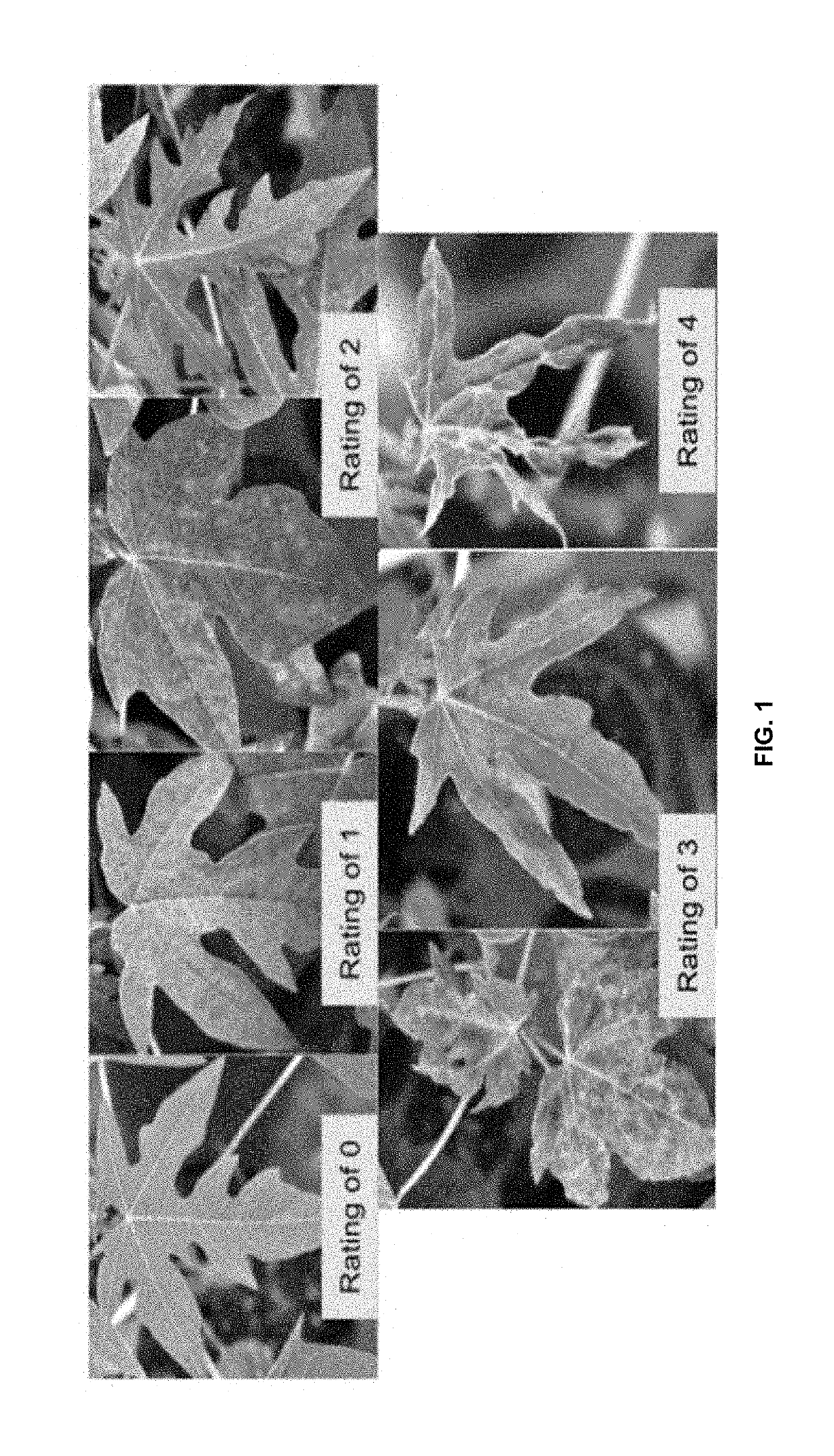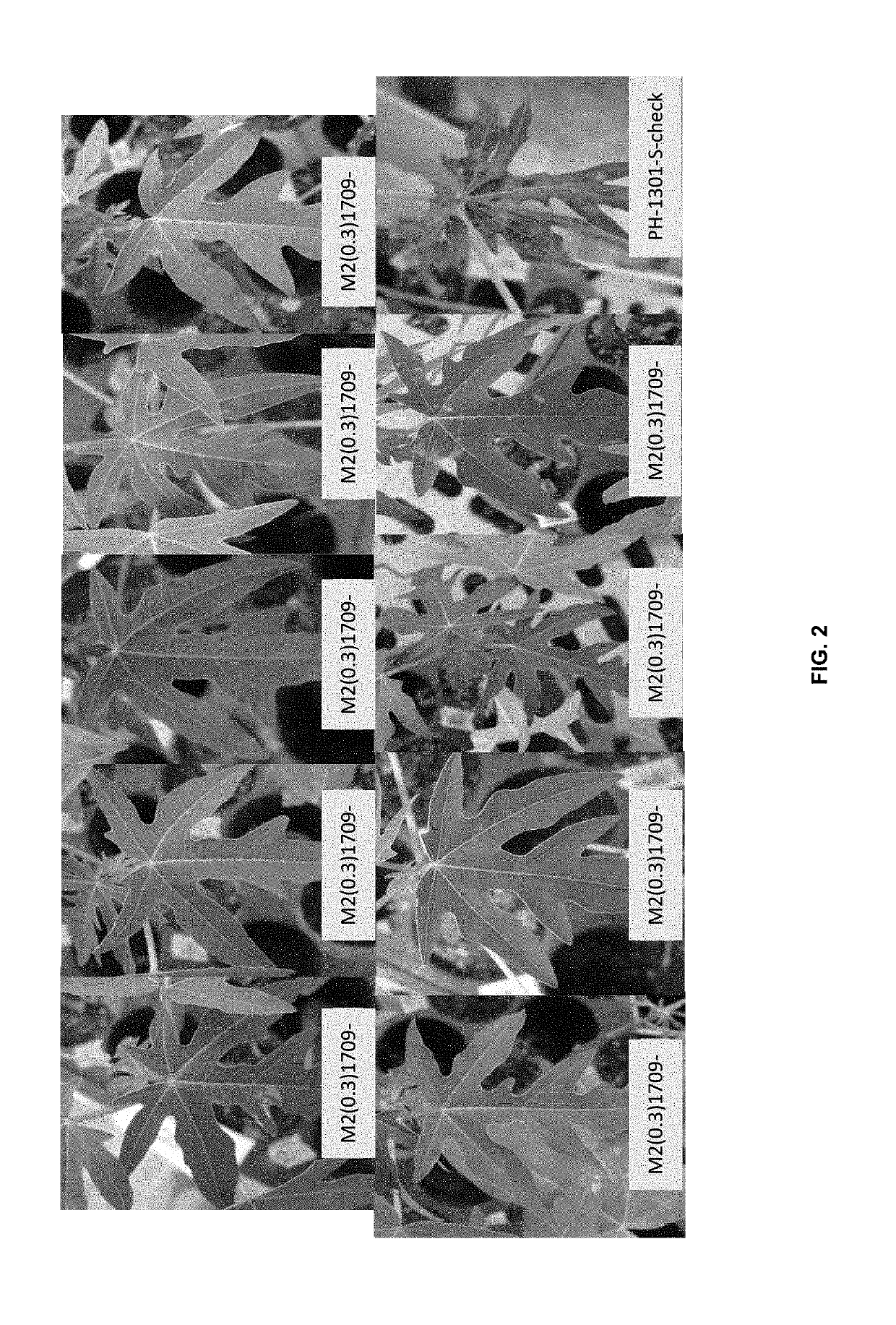Papaya with novel traits and methods for producing such papaya plants
a papaya plant and novel technology, applied in the field of new traits in papaya plants, can solve the problems of high cost of chemical control of vectors, insufficient protection, and loss of prsv, and achieve the effect of increasing resistance to the papaya ringspot virus
- Summary
- Abstract
- Description
- Claims
- Application Information
AI Technical Summary
Benefits of technology
Problems solved by technology
Method used
Image
Examples
example 1
is and DNA Extraction
[0089]Papaya seeds (10,000 seeds, called M0) of the breeding line (BVC#13243-2398) were washed with water and treated with 1M KNO3 and then placed on a shaker (100 rpm) for overnight incubation. The mutagen ethyl methanesulfonate (EMS) was added under a fume hood to the imbibing seeds to final concentrations ranging from about 0.1% to about 1.6% (v / v). The treated seeds (called M1) were then incubated for a period of 6 to 12 hours, and the seeds were then rinsed with running water for approximately one hour. The mutagenized seeds were planted in potted trays and allowed to germinate in the nursery. Plants that were four to six weeks old were transferred to the field to grow to fully mature M1 plants. The flowers on the mature M1 plants were hermaphrodite and self-pollinated and then M2 seeds were collected from individual plants.
[0090]DNA extractions of M2 were performed using Qiagen plant DNA extraction kit following manufacturers instruction. Ten seeds per M2 ...
example 2
Detection
[0091]Nested PCR was carried out by using target gene specific primers on 5 ng of papaya M2 genomic DNA. The first Ni PCR amplified product (1 μl) was used by diluting 1:10, which served as a template for the nested PCR, using 5′end infra-red dyes (IRD) labeled combinations of IRD700 and IRD800 M13 universal primers along with unlabeled N2 primers with M13 sequence and the section of Ni primer sequence
example 3
atic Analysis
[0092]CODDLE (Codons Optimized to Discover Deleterious Lesions,) was used to ascertain regions of the target gene in which G / C to A / T transitions, which are most likely to result in deleterious effects on the protein, had occurred. PARSESNP (Project Aligned Related Sequences and Evaluate SNPs,) was used to demonstrate the distribution of mutations within the target gene, and to indicate the nature of each single mutation. To predict the impact of the mutation on the target protein sequence, SIFT (Sorting Intolerant from Tolerant,) analysis and PPOPEN software analysis was done. ClustalW was utilized for Multiple Sequence Alignment of the gene of interest. Primers were designed according to the M13 TILLING system for each gene (Triques et al., 2007). TILLING primers for eIF4e (SEQ ID NOs: 8-19) and eIF(iso)4e (SEQ ID NOs: 26-49) were designed by Primer 3 software and further TILLING were carried out.
PUM
| Property | Measurement | Unit |
|---|---|---|
| OD | aaaaa | aaaaa |
| resistance | aaaaa | aaaaa |
| genome size | aaaaa | aaaaa |
Abstract
Description
Claims
Application Information
 Login to View More
Login to View More - R&D
- Intellectual Property
- Life Sciences
- Materials
- Tech Scout
- Unparalleled Data Quality
- Higher Quality Content
- 60% Fewer Hallucinations
Browse by: Latest US Patents, China's latest patents, Technical Efficacy Thesaurus, Application Domain, Technology Topic, Popular Technical Reports.
© 2025 PatSnap. All rights reserved.Legal|Privacy policy|Modern Slavery Act Transparency Statement|Sitemap|About US| Contact US: help@patsnap.com


